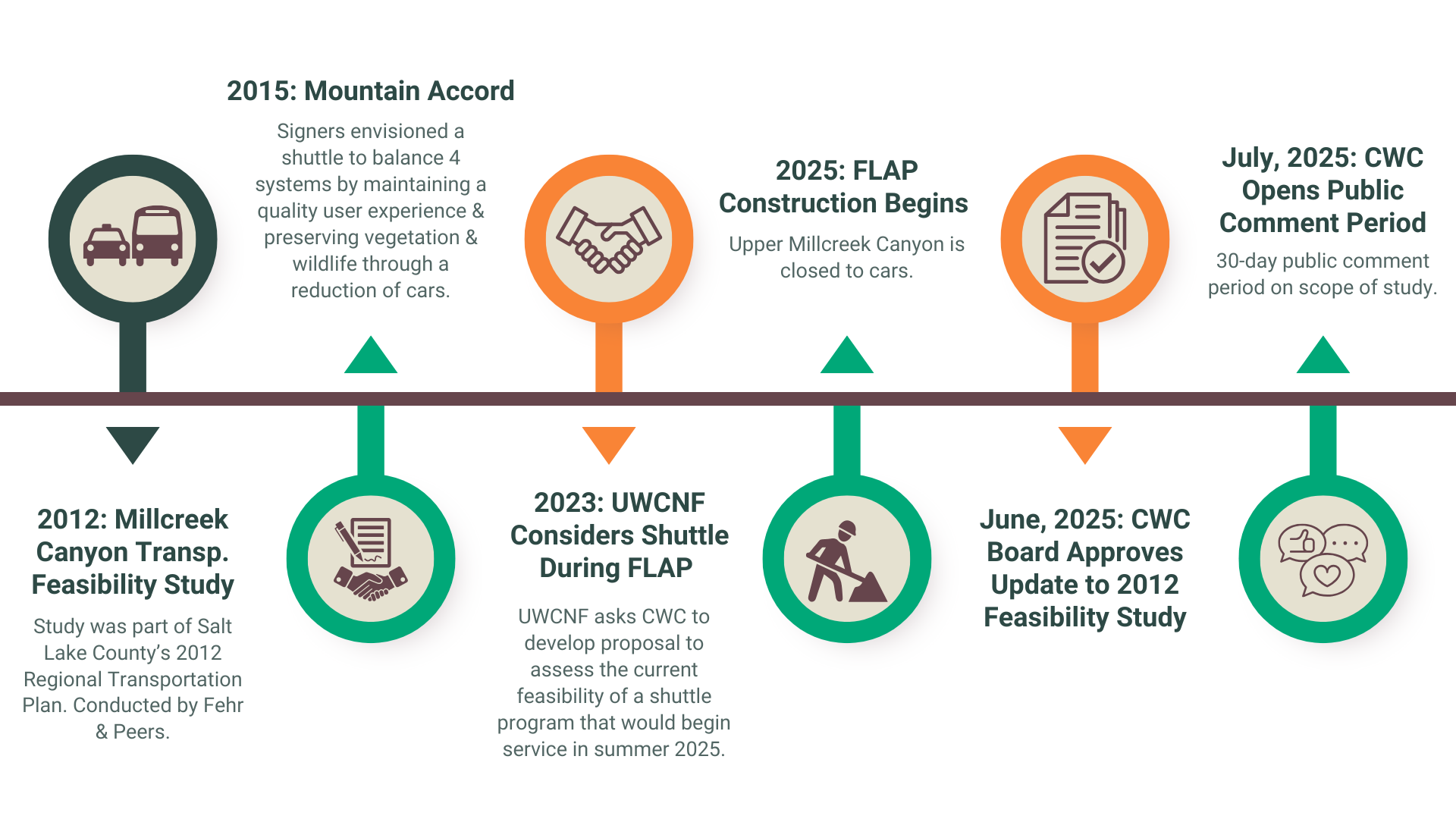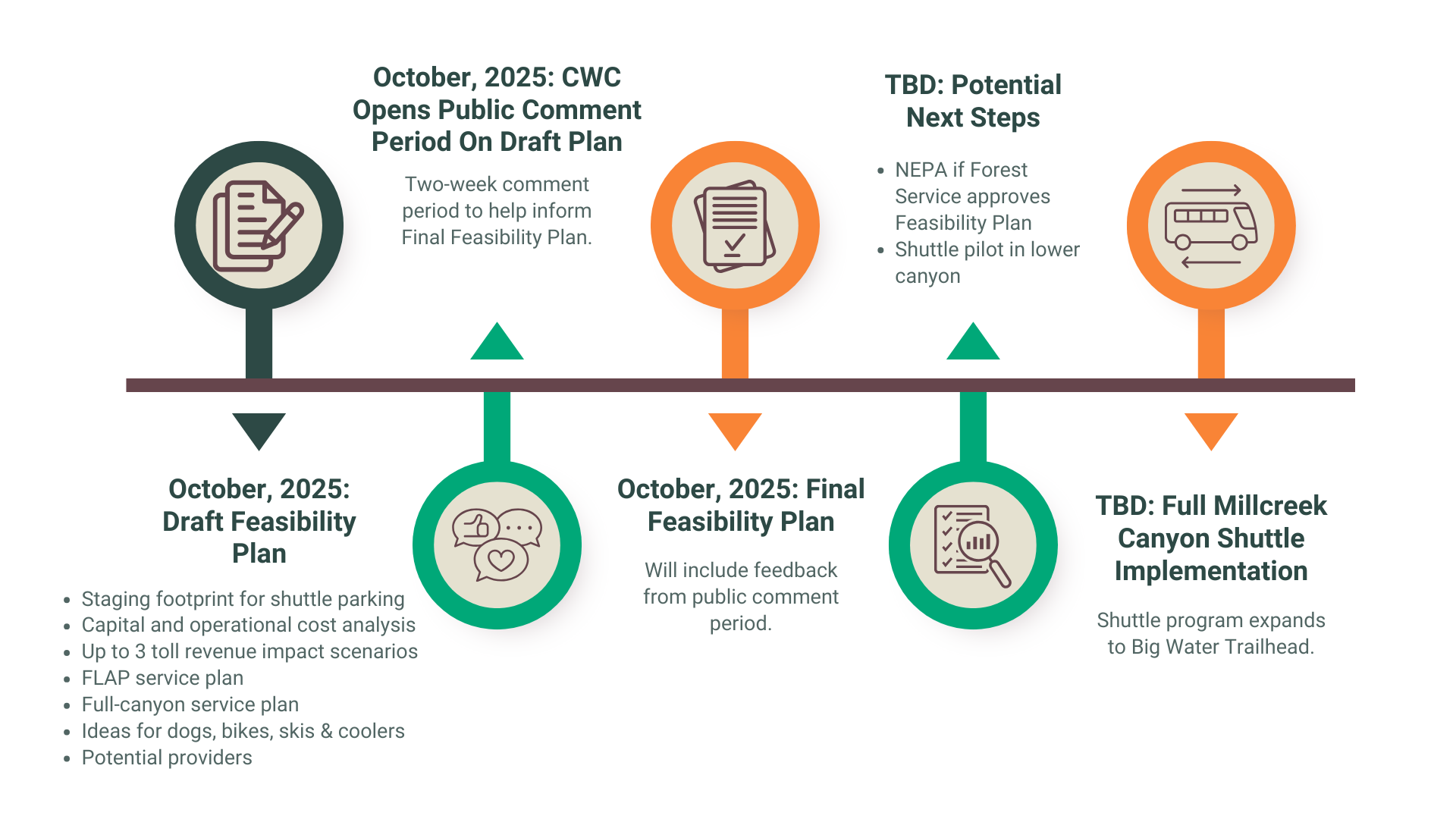Millcreek Canyon Shuttle
From the dawn of the Mountain Accord, the signers have envisioned a Millcreek Canyon shuttle. A shuttle would help maintain a quality user experience and preserve vegetation and wildlife through a reduction of canyon vehicular presence—so that the four systems (environment, transportation, recreation, and economy) identified in the Mountain Accord remain in balance.
Salt Lake County’s 2012 Regional Transportation Plan included the 2012 Millcreek Canyon Transportation Feasibility Study conducted by Fehr & Peers. The study sought to address the primary issues in the canyon: full parking lots at popular trailheads, illegal parking on the roadway, pedestrians walking long distances on the main road to reach popular trailheads, and watershed degradation, loss of vegetation, and erosion caused by overflow parking. The project team looked into parking management concepts, transit concepts, and bicycle and pedestrian concepts.
For the transit concept, the study looked into a winter shuttle, a summer all-canyon shuttle, and a summer upper canyon shuttle outfitted with capabilities for hauling bikes, skis, dogs, and more. Ten years later, the CWC completed a Visitor Use Study, providing valuable information for an updated shuttle feasibility study. With populations along the Wasatch Front trending upward and the desire to spend time in this stunning canyon only increasing, an updated study was found to be warranted.
Development & Execution
Because Upper Millcreek Canyon is closed for construction from summer 2025 through summer 2027—resulting in a temporary loss of many parking spaces—the Uinta-Wasatch-Cache National Forest (UWCNF) began considering a shuttle program to service the lower canyon. In 2023 UWCNF approached the CWC to research and develop a proposal to assess the current feasibility of a shuttle program that could begin service during FLAP construction and adapt as construction continues in the canyon.
The updated Mill Creek Shuttle Feasibility Study is being performed by Fehr & Peers, the Salt Lake City-based transportation planning firm that conducted the original 2012 Feasibility Study.
The CWC opened a comment period on the Fehr & Peers scope of study, and received more than 350 comments that will be incorporated into this work. When Fehr & Peers has a draft of the feasibility study (early October, 2025), the CWC will open a two week comment period. Fehr & Peers will consider this second round of public comments and incorporate them into the final feasibility study, around the end of October.
Public Comments on Scope of Study
The CWC’s 30-day comment period on the scope of the Millcreek Canyon Shuttle Feasibility Study ran from July 14, 2025 through August 12, 2025. 375 people commented. See the report here. View the comments and our responses here.
Draft Report and 2-Week Public Comment Period
The draft update to the shuttle option outlined in the 2012 Mill Creek Canyon Transportation Feasibility Study is available, and the Central Wasatch Commission accepted public comments from October 2, 2025 through October 16, 2025.
A Mill Creek Canyon shuttle has been part of the Mountain Accord vision from the beginning, and the CWC has never lost sight of that. In particular, the Stakeholders Council’s Millcreek Canyon Committee has worked tirelessly to keep the shuttle concept front of mind for the CWC. In keeping with the goals of the Mountain Accord Charter, the shuttle would help maintain a quality user experience and preserve vegetation and wildlife through a reduction of canyon vehicular presence—so that the four systems (environment, transportation, recreation, and economy) identified in the Mountain Accord remain in balance.
This study is an update to a section of the 2012 Mill Creek Canyon Transportation Study, which identified a shuttle as one potential transit solution for the canyon. Because upper Mill Creek Canyon is closed for construction through fall 2026—resulting in a temporary loss of many parking spaces—the Uinta-Wasatch-Cache National Forest (UWCNF) began considering a shuttle program to service the lower canyon. UWCNF approached the CWC to research and develop a proposal to assess the current feasibility of a shuttle program that could begin during construction and adapt as the improved and widened road reopens. This updated study sought to address the UWCNF‘s outstanding questions about the shuttle option: cost and parking locations. Beginning in June, 2025, Fehr & Peers, a Salt Lake City-based transportation planning firm conducted the update to the study.
During the scoping phase earlier this summer, the CWC opened a 30-day comment period and received 375 responses. Patrons of the canyon weighed in with their shuttle preferences: convenience, bike, ski, dog, and picnicking accommodations, year-round availability, and short wait times, among other things. The information gathered from these comments has been incorporated into the report draft, where feasible.
To determine the feasibility of a Mill Creek Canyon Shuttle, these analyses were performed:
- Review of past studies and existing conditions.
- Calculations of parking demand.
- Scoping of possible staging areas for shuttle operation.
- Shuttle operations’ impact on recreation fees.
- Estimation of operation costs and the creation of a shuttle service plan.
Implementation
We will update this page as the project progresses and more information becomes available. Stay tuned.


